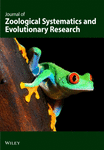The brain of the Malayan bear (Helarctos malayanus)
Abstract
This little known ursid has a brain that shows very progressive encephalization and neocorticalization, reminiscent of the giant panda's. But, somewhat paradoxically, it is also characterized by proportionately large rhinencephalon and brain stem, and relatively small striatum. This quantitative study suggests a general contrast between Asian and American bears. It invites further comparative investigations of the brain in all ursiform mammals, as an especially promising material from combined evolutionary and neuroethological standpoints.




